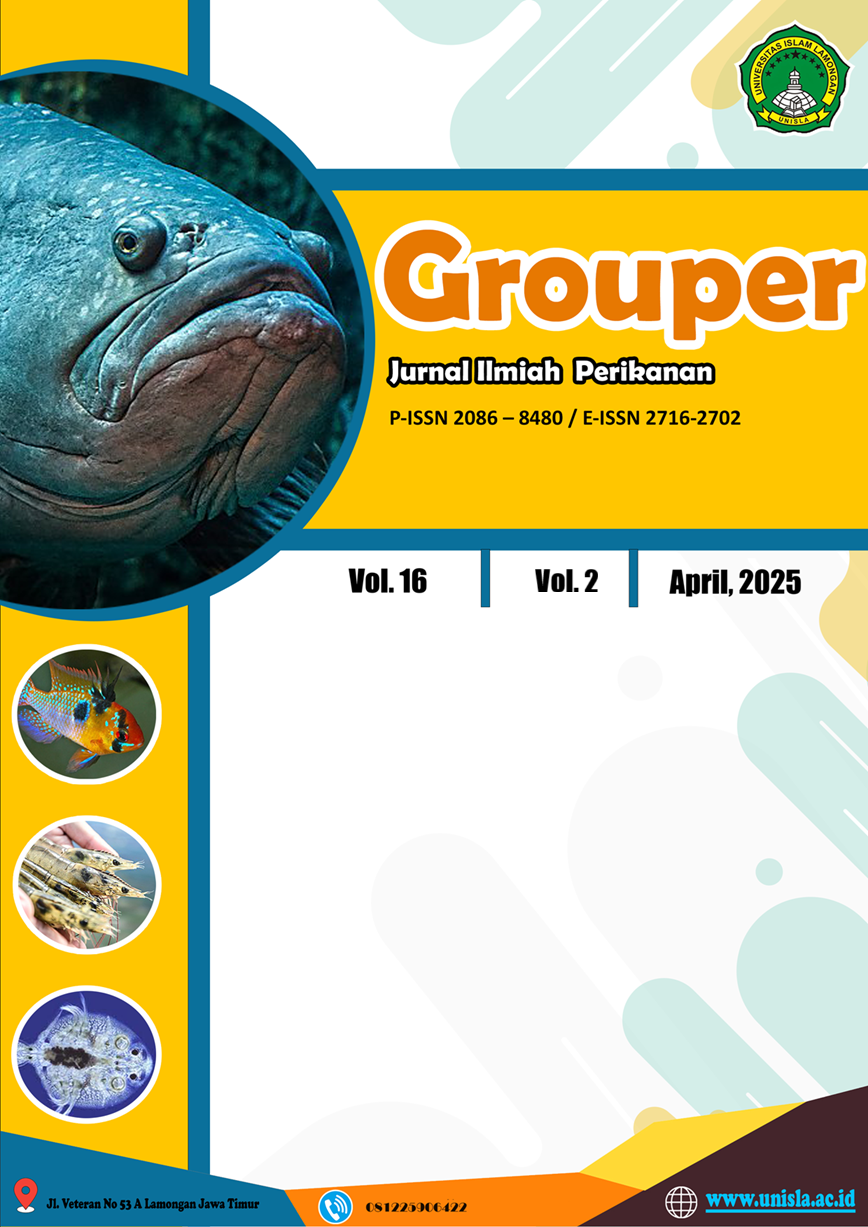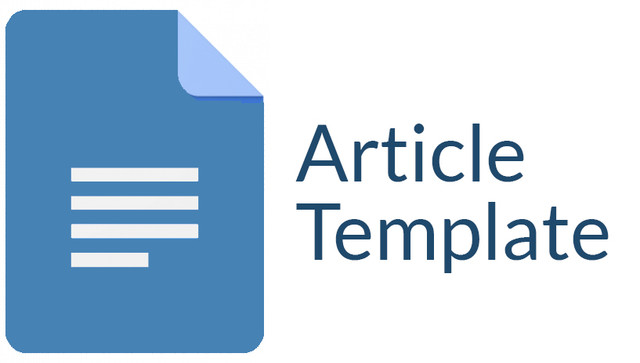Microplastic Analysis in Mackarel Tuna and Milkfish at Selili Fish Landing Site, East Kalimantan
DOI:
https://doi.org/10.30736/grouper.v16i2.326Keywords:
Microplastic, Mackarel Tuna, Milkfish, PPI Selili, ANOVA, RegressionAbstract
Microplastic pollution in coastal waters poses a serious threat to marine ecosystem sustainability and food safety. However, data on microplastic contamination in edible fish from the Selili Fish Landing Station (PPI Selili), Samarinda, remains limited. This study aimed to identify the types and abundance of microplastics in mackarel tuna (Euthynnus affinis) and milkfish (Chanos chanos), and to analyze the relationship between fish size and microplastic count. The methodology involved random sampling, microplastic extraction from digestive tracts using 22% KOH solution, and statistical analysis using ANOVA and linear regression. The results showed that mackarel tuna contained an average of 3.87 particles per individual, while milkfish had 1.8 particles per individual. The dominant type of microplastic in both species was film (>80%). ANOVA revealed a significant difference in microplastic abundance between the two species (p = 0.010), whereas regression analysis indicated that fish length and weight had no significant effect on microplastic quantity (R² < 0.03). In conclusion, mackarel tuna are more prone to microplastic accumulation than milkfish, likely due to differences in habitat and feeding behavior. It is recommended to conduct regular monitoring of water quality and educate local communities about reducing single-use plastic to minimize microplastic pollution around PPI Selili.
Downloads
References
Arifin, Z., Wulandari, E., & Santoso, A. B. (2022). Microplastic abundance in demersal and pelagic fish in Indonesian waters. Marine Research Journal, 10(2), 105–114.
Aryani, R. T., Wahyuni, S., & Prabowo, R. (2024). Trophic level differences and microplastic ingestion in pelagic fishes. Indonesian Journal of Marine Science, 19(1), 23–32.
Auta, H. S., Emenike, C. U., & Fauziah, S. H. (2017). Distribution and importance of microplastics in the marine environmentA review of the sources, fate, effects, and potential solutions. Environment International, 102, 165–176. https://doi.org/10.1016/j.envint.2017.02.013
Azuri, L., Yuliani, T., & Hermanto, R. (2024). Size-based patterns of microplastic ingestion in commercial fish. Jurnal Ilmu Perikanan Tropis, 21(1), 87–94.
Barboza, L. G. A., Vieira, L. R., Branco, V., Figueiredo, N., Carvalho, F., & Guilhermino, L. (2018). Microplastics cause neurotoxicity, oxidative damage and energy-related changes in fish. Ecotoxicology and Environmental Safety, 175, 695–702.
Barnes, D. K. A., Galgani, F., Thompson, R. C., & Barlaz, M. (2009). Accumulation and fragmentation of plastic debris in global environments. Philosophical Transactions of the Royal Society B: Biological Sciences, 364(1526), 1985–1998. https://doi.org/10.1098/rstb.2008.0205
Bessa, F., Barría, P., Neto, J. M., Frias, J. P. G. L., Otero, V., Sobral, P., & Marques, J. C. (2018). Microplastics in Juvenile Commercial Fish from an Estuarine Environment. Springer Water, 128, 131–135. https://doi.org/10.1007/978-3-319-71279-6_18
Cordova, M. R., Wulandari, E., & Riani, E. (2021). Land-based sources of microplastic pollution in Indonesian rivers. Environmental Pollution, 284, 117377.
GESAMP Joint Group of Experts on the Scientific Aspects of Marine Environmental Protection. (2015). Sources, fate and effects of microplastics in the marine environment: a global assessment”. In Reports and Studies GESAMP (Vol. 90). issn: 1020-4873%5Cnhttp://ec.europa.eu/environment/marine/good-environmental-status/descriptor-10/pdf/GESAMP_microplastics full study.pdf
Geyer, R., Jambeck, J. R., & Law, K. L. (2017). Production, use, and fate of all plastics ever made. Science Advances, 3(7). https://doi.org/10.1126/sciadv.1700782
Hernandez, E., Nowack, B., & Mitrano, D. M. (2017). Polyester Textiles as a Source of Microplastics from Households: A Mechanistic Study to Understand Microfiber Release during Washing. Environmental Science and Technology, 51(12), 7036–7046. https://doi.org/10.1021/acs.est.7b01750
Islamiya, H. (2020). Identification of microplastic in demersal fish in estuarine aquaculture areas. Jurnal Akuakultur Tropis, 5(2), 72–79.
Downloads
Published
How to Cite
Issue
Section
License
Copyright (c) 2025 Mahesa Islamy Eka Juniar, Abdunnur, Moh Mustakim, Irwan Suyatna, Fitriyana

This work is licensed under a Creative Commons Attribution-NonCommercial-ShareAlike 4.0 International License.







.jpg)
1.png)



